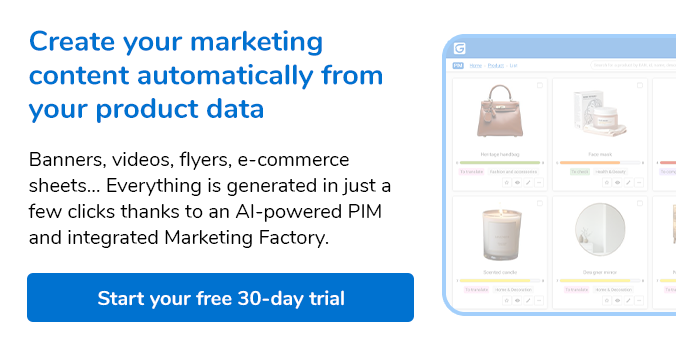With the advent of all things digital, online sales have grown exponentially: the volume of sales through e-commerce is increasing three times faster than physical sales.1 This phenomenon has an impact on the customer journey: in-store points of sale, e-commerce sites, the mobile shopping experience are all sales channels, but also points of contact with the brand.
Faced with the multiplication of distribution channels, an increasing number of businesses are turning to PIM solutions to provide an omnichannel retail experience for their customers, let's look at the advantages and benefits of this solution.
#PIM, the strategic asset for e-commerce professionals?
While physical and digital points of contact are multiplying, customers are increasingly demanding in their search for a perfectly fluid omnichannel retail experience.For the company, the challenge is to send out the relevant product information, at the right time, on the right channel, and in the right context. This action is difficult when product data is desynchronized and scattered over several different channels.. Choosing to use PIM software is the opportunity to gain control over the management of product information.
#Deliver a coherent Product Experience
In this era of real time consumption, customer expectations are constantly changing. For this reason, marketing professionals are expected to provide ever more dynamism and rapidity. It is now impossible to create an e-commerce strategy without a guarantee of a fluid customer journey on all sales channels. More than a necessity, it's an obligation if you want to reduce the number of cart abandonments and increase the sales conversion rate.
In response to these new challenges, the product information management software solutions, commonly known as PIM appear to be the corner stones of a coherent customer journey. Capable of structuring and synchronizing product information, the PIM allows e-commerce professionals to anticipate and program an on time distribution of product data on all shopping channels (Platform, e-commerce website, Marketplace). It's a means of harmonizing the customer journey and of optimizing their online shopping experience.

In addition to their online stores (PrestaShop or Magento), an increasing number of e-commerce professionals are distributing their products on multi-vendor sites, more commonly known as Marketplaces (Amazon, Cdiscount, La Redoute...). To integrate their eShop, vendors must comply with a number of specifications in the design and presentation of their product datasheets. To guarantee homogenous product information, in compliance with the standards of each reference base, the PIM is an effective means of harmonizing product information on all sales channels.
#Rely on a unique product Reference source

Beyond the customer related challenge, consistency is also an issue for the various internal departments. Product information is often used in different ways by many separate departments within the same supply chain. Result: product data is dispersed, and sometimes broken down between different resources. As such, product data is generally managed by an ERP (Enterprise Resource Planning) while sales data is managed by a CRM (Customer Relationship Management) and marketing data is processed in Excel. Over time, this breakdown of information can generate errors on product datasheets and slow down the Time to market.
To rise to these challenges, businesses are more and more frequently turning to PIM software. By structuring and centralizing product information on a unique platform, all of the company's services can refer to a master database known as the unique reference source. For businesses with both physical and ecommerce stores, PIM facilitates the management of data coming from different sources. It guarantees the distribution of reliable and effective product data.
#Collaborate to enhance product data

While the consistency and centralization of data are crucial elements, the level of detail is also of critical importance. We often mistakenly believe that a customer's decision to buy is based on price and/or customer feedback. However, 98% of buyers are deterred from buying due to a lack of product information.2
And rightly so: the factor with the most influence on the customer's decision to purchase is the level of detail on its product datasheet. This stands out as an essential differentiating element to get ahead of the competition. The consumer sees a detailed product datasheet with high quality content as an indication of the company's expertise and professionalism. Reassured and confident, the customer can make their purchase, after having selected their preferred articles online. As such, the PIM workflow engine enables each stakeholder to participate in improving product data depending on their rights (specific characteristics and fields) and to follow the progress of a project step by step (open, ongoing, awaiting approval, validated…).
For e-commerce professionals, the PIM is an opportunity to gain control over the management of product information and to provide the customer with an optimal, agile and coherent experience from start to finish of the customer journey. Strategic advantages that are nowadays crucial to be able to stand out in an ultra-competitive environment and to gain the trust of consumers. Check out the Goaland PIM solution, with its advanced features for all these issues.
1E-COMMERCE : 25% DU SECTEUR DE LA MODE D'ICI 2020 (BCG). (2018, printemps 12).
2Leggat, H. (2017, février 21). 98% of shoppers deterred by incomplete content in apps and websites.







